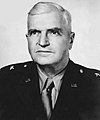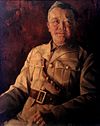
Lieutenant General Richard Kerens Sutherland was a United States Army officer during World War II. He served as General of the Army Douglas MacArthur's Chief of Staff in the South West Pacific Area during the war.
Brigadier general or brigade general is a military rank used in many countries. The rank is usually above a colonel, and below a major general or divisional general. When appointed to a field command, a brigadier general is typically in command of a brigade consisting of around 4,000 troops or.
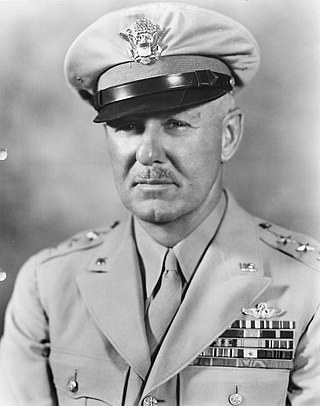
George Howard Brett was a United States Army Air Forces General during World War II. An Early Bird of Aviation, Brett served as a staff officer in World War I. In 1941, following the outbreak of war with Japan, Brett was appointed Deputy Commander of a short-lived major Allied command, the American-British-Dutch-Australian Command (ABDACOM), which oversaw Allied forces in South East Asia and the South West Pacific. In early 1942, he was put in charge of United States Army Forces in Australia, until the arrival of Douglas MacArthur. Brett then commanded all Allied Air Forces in the Southwest Pacific Area. In November 1942, he was appointed commander of the US Caribbean Defense Command and remained in this post for the rest of the war.
Aubrey Thomas Hornsby I was a U.S. Army officer and pioneer aviator who reached the rank of Brigadier General. He began his Army career during World War I as an artillery observer, seeing service in France and Germany, then continued to serve as an aviator and administrator through World War II, after which he was elected to the Alabama House of Representatives.

"The class the stars fell on" is an expression used to describe the class of 1915 at the United States Military Academy in West Point, New York. In the United States Army, the insignia reserved for generals is one or more stars. Of the 164 graduates that year, 59 (36%) attained the rank of general, more than any other class in the history of the academy, hence the expression. Two graduates reached the rank of five-star General of the Army, two were four-star generals, seven three-star lieutenant generals, 24 two-star major generals, and 24 one-star brigadier generals. Dwight D. Eisenhower, one of the five-star generals, went on to become the 34th President of the United States. The other, Omar Bradley, became the first Chairman of the Joint Chiefs of Staff, under Presidents Harry S. Truman and Eisenhower.
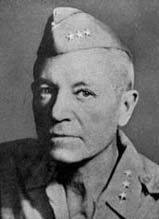
Lieutenant General Oscar Woolverton Griswold was a United States Army officer who served in the first half of the 20th century. He is best known for his command of the XIV Corps in the South Pacific Area and South West Pacific Area during World War II.

Brigadier General James Creel Marshall was a United States Army Corps of Engineers officer who was initially in charge of the Manhattan Project to build an atomic bomb during World War II.

Major General Jens Anderson Doe was a senior United States Army officer who fought with distinction in both World War I and World War II. He is best known for his command of the 41st Infantry Division in the South West Pacific Area during World War II.
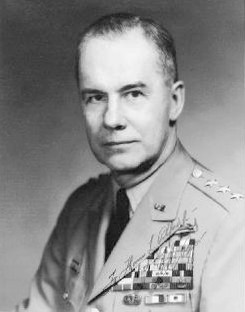
Lieutenant General Clovis Ethelbert Byers was a United States Army officer who served in the first half of the 20th century. He is best known for his role as Chief of Staff of the Eighth Army in the South West Pacific Area during World War II and in the occupation of Japan. He was wounded while leading American troops from the front at the Battle of Buna-Gona, and also played an important part in the fighting at Lone Tree Hill, Biak, and the Philippines campaign (1944–45).
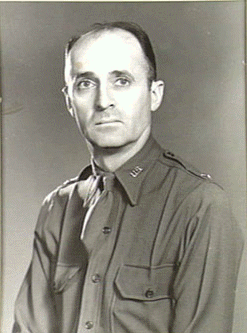
Brigadier General Dwight Frederick Johns was an American soldier and general in the first half of the 20th century. He is best known for his service in the South West Pacific Area during World War II, where he headed the Advance Base and the Combined Operations Service Command during the Kokoda Track campaign and the Battle of Buna-Gona. He later commanded the Advance Base at Lae and Finschhafen, and the Engineer School at Fort Belvoir. After the war he headed the Pacific Engineer Division, where he was responsible for a number of important flood control and irrigation projects.

Ennis Clement Whitehead was an early United States Army aviator and a United States Army Air Forces general during World War II. Whitehead joined the U. S. Army after the United States entered World War I in 1917. He trained as an aviator and served in France, where he was posted to the 3d Aviation Instruction Center and became a qualified test pilot. After the war, Whitehead returned to school at the University of Kansas. After he graduated, he was commissioned as a first lieutenant in 1920.

Ralph Royce was a United States Army Air Forces general during World War II. A West Point graduate who learned to fly in 1915–16, he served with the 1st Aero Squadron in the Pancho Villa Expedition and later led it on the Western Front. During World War II as a brigadier general, he led the Royce special mission to Mindanao, in which a small force of bombers flew from Australia to attack Japanese targets in the Philippines. Later he was Deputy Commander of the Ninth Air Force and commanded the 1st Provisional Tactical Air Force.
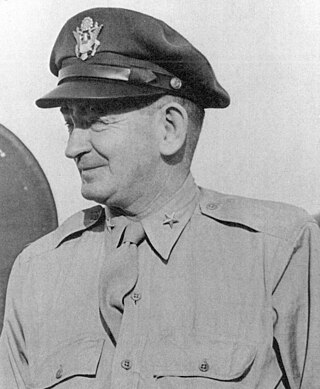
Howard Knox Ramey was a United States Army Air Forces general during World War II. Ramey learned to fly in 1918 during World War I and served as an instructor at the Air Corps Advanced Flying School and as a staff officer with the 1st Bombardment Wing between the wars. He was commander of the IV Bomber Command from 12 August 1942 to 8 November 1942, and was promoted to brigadier general on 17 September 1942. In November 1942, he became deputy commander of the Seventh Air Force in Hawaii. In January 1943, he became the commander of the V Bomber Command in Australia and Papua, which he led during the Battle of the Bismarck Sea. Later that March, he disappeared on a reconnaissance flight over the Torres Strait. Neither his aircraft nor his body has ever been found.
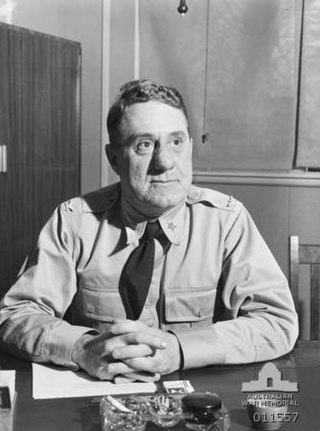
Stephen Jones Chamberlin was a lieutenant general in the United States Army who served during World War II as General of the Army Douglas MacArthur's Assistant Chief of Staff, G-3, the staff officer in charge of plans and operations.

Raymond D. Tarbuck was a rear admiral in the United States Navy who is best known as a planner with General Douglas MacArthur's General Headquarters (GHQ) Southwest Pacific Area during World War II.
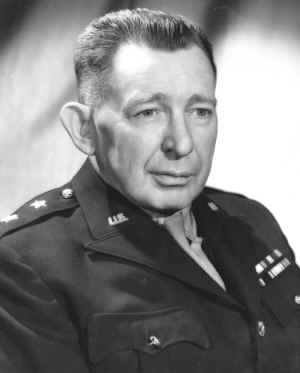
Robert McGowan Littlejohn was a major general in the United States Army who graduated from the United States Military Academy at West Point, New York, in 1912. He served with the Pancho Villa Expedition and on the Western Front during the First World War, and was Chief Quartermaster for the European Theater of Operations during the Second World War. For this service, he received the Distinguished Service Medal. Upon retirement from the Army in 1946, then President of the United States Harry S. Truman appointed him head of the War Assets Administration.

Clare Hibbs Armstrong was a highly decorated officer in the United States Army with the rank of brigadier general. A graduate of the United States Military Academy, he was the commanding officer of the 50th Anti-Aircraft Artillery Brigade during the air defense of Antwerp during World War II. The 50th Anti-Aircraft Artillery Brigade destroyed 97% of all V-1 flying bombs aimed at the docking facilities that supplied the 12th and 21st Army Groups.

Major General Ewart Gladstone Plank was a United States Army career officer who was a veteran of World War I and World War II. A graduate of the United States Military Academy at West Point, New York, he was ranked 44th in the class of 1920. He was commissioned in the Coast Artillery Corps, but later transferred to the Corps of Engineers. During World War II he commanded the Advance Section, Communications Zone (ADSEC).

Royal Bertrand Lord was a United States Army general who served in World War II.

